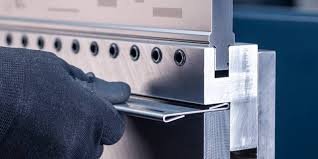What Is Hemming in Sheet Metal Bending and How Is It Done?
Have you ever noticed the bent edges of some metal parts? Do you know which technique has been used to achieve that look? One popular method that metalworkers use for this purpose is hemming. By using a sheet metal hem tool, they make metal parts stronger and enhance their aesthetics.
Hemming in sheet metal bending is a technique of folding the edge of a metal sheet over itself to reinforce it or enhance its appearance. It helps eliminate sharp edges, hide imperfections, and provide extra strength. The process can also create a smooth, clean finish.
We’ll discuss in detail how hemming works and why it’s a go-to method for improving sheet metal products. We’ll also focus on the techniques and applications of this method.
Hemming in Sheet Metal Bending
Hemming is not just for covering the rough edges of metal sheets or to create a finished look. It also adds durability to the final products. Let’s dig into its role in bending sheet metal:
What Is Hemming and Why Is It Important?
In sheet metal bending, hemming is a technique that adds strength, smoothness, and durability to the final product. It’s especially useful for hiding imperfections that may occur during the initial bending process, like burrs or rough edges. It provides a way to tidy up the sheets while simultaneously reinforcing them. Whether you’re working with high-gauge or low-gauge metals, it’s a step that helps ensure precision and quality.
So, why exactly is hemming so important? For one, it strengthens the sheet metal. By folding the edge over itself, the metal becomes more rigid, reducing its susceptibility to bending, warping, or cracking under stress. In industries like automotive manufacturing, where parts often endure extreme conditions, this added durability is invaluable. Also, hiding the rough edges makes these parts safer to handle.
A well-executed hem also contributes to the overall aesthetic of the metal part. It can create smooth, clean edges that align perfectly with the rest of the material. This polished look is especially important when the appearance of the final product is an important selling point.
Techniques for Creating Folded Edges in Sheet Metal
Creating folded edges in sheet metal is an essential part of many manufacturing processes. It’s done for many reasons, including strengthening a part, improving its appearance, or adding functionality.
We’ve already mentioned hemming, which is a go-to method for creating these edges. Here’re some other common methods used for this purpose:
1. Air Bending
In this method, the bending is done using a press brake with a V-shaped punch and die. The punch presses the metal between the die and the punch, forming a bend without the workpiece touching the bottom of the die.
The process is highly versatile and relies on the material’s properties to achieve the desired angle. It’s great for creating bends at varying angles and is one of the more common techniques used for folded edges.
2. Roll Bending
Another technique is roll bending, often used when a smooth, gradual curve is needed. The technique involves passing a sheet metal between rotating rollers, which gradually shape the metal into a cylindrical or curved form. The method is especially useful for parts like pipes, but it can also be employed to create smooth folded edges for other sheet metal components.
3. Coining
For those looking for sharp, precise bends, coining is an excellent option. This high-pressure method uses a press brake to apply intense force, ensuring the metal conforms perfectly to the die. The result is a precise, crisp bend with minimal springback, making coining ideal for applications where accuracy is important.
4. Bottom Bending
Bottoming, or bottom bending, is another reliable method. Here, the workpiece is pressed between a punch and a die.
This technique is effective for achieving precise bends and is commonly used in more traditional sheet metal operations. The direct pressure applied to the workpiece ensures a tight, accurate fold.
5. Curling
Curling is a process that forms a hollow ring at the edge of the metal. It’s commonly used to remove sharp edges and to increase the material’s strength by improving its moment of inertia. Curling also serves functional purposes, like creating parts for door hinges, where the edge must be rounded for proper movement.
Applications of Hemming in Automotive and Appliance Manufacturing
Hemming in sheet metal bending is used in both automotive and appliance industries, providing benefits that go far beyond just a clean, smooth finish. Let’s discuss in detail:
Automobile Manufacturing
In the automotive world, a sheet metal hem is especially valuable for joining two metal parts together. After the more complex forming processes like deep drawing and trimming, hemming is typically used to fold the edges of body panels such as hoods, doors, and trunk lids. These folded edges add strength to the parts and eliminate sharp corners, making the vehicle safer and more appealing.
By reinforcing the edges, the panels are less likely to bend or warp under stress, improving their overall durability and ability to withstand impacts, vibrations, and even extreme weather.
For example, car doors are hemmed along the edges to improve their structural integrity, reduce the risk of injury from sharp edges, and add to their aesthetic. This technique is used on a wide range of vehicle parts, including fenders, hoods, panels, trims, etc. to enhance both their appearance and functionality.
Appliance Manufacturing
Different components of refrigerators, washing machines, ovens, and other appliances use sheet metal parts. These parts often require strong, clean edges to enhance safety and performance. Hemming is commonly applied to appliance doors, panels, and other structural components for these purposes.
For example, the edges of refrigerator doors are hemmed to provide a smooth appearance while also reinforcing the frame. This reduces the risk of cuts or scrapes during use and enhances the overall structural integrity of the door.
Similarly, washing machine and dryer housings are hemmed to improve both their aesthetics and durability. The hemmed edges keep the components secure and protected. In addition to these practical benefits, hemmed edges also help create tight seals between components, which is important for appliances like ovens and refrigerators that need to be airtight to function properly.
Tools and Machines Used for Hemming Processes
Sheet metal hemming requires specific tools and machinery to manufacture neat, durable edges. The common items you’ll need are:
- Sheet metal: It needs to be flat and free of any contaminants that could affect the final result.
- Sheet metal hemming tool or press brake: This machine applies force through a punch and die to create the fold. It allows for precise control of the bend angle and depth.
- Flattening tool (plier, press, or roller): For some hemming tasks, especially those that involve creating a smooth or rounded edge, you need a flattening tool. It could be a roller, plier, or press that helps refine the fold.
- Finishing tool (hammer or sandpaper): It can be a hammer or sandpaper, depending on the required finish.
- Quality inspection tools (micrometer): These tools check the accuracy of the hem, measuring things like thickness, width, and alignment to make sure the result is consistent and meets the required standards.
There are two main methods for hemming, each requiring different tools:
Conventional Die Hemming: In this method, a punch and die work together to fold the edge of the metal. The die is positioned beneath the sheet metal, and the punch forces the metal over it, creating a strong, uniform hem. This method is widely used for parts that require precise, high-quality hems.
Roll Hemming: Instead of a punch and die, roll hemming uses a specialized hemming roller to gently fold the metal’s edge. It’s ideal for parts that need a softer bend or thinner sheet metal. The roller applies consistent, controlled pressure to roll the edge over smoothly, making it perfect for delicate applications.
Conclusion
Hemming in sheet metal bending is more than just a technique for neat edges; it’s essential for adding strength, safety, and aesthetic appeal to sheet metal products. Despite being simple, the process is quite effective. While the tools and techniques may vary, the goal remains the same: to create parts that last, look good, and perform well. If you’re new to metalworking, understanding hemming is a great first step toward mastering sheet metal fabrication.
We, at Zintilon, are experts in custom machined parts. You can take our fabrication or CNC machining services for various industries. Contact us and get our rates for prototypes or full-scale production.







